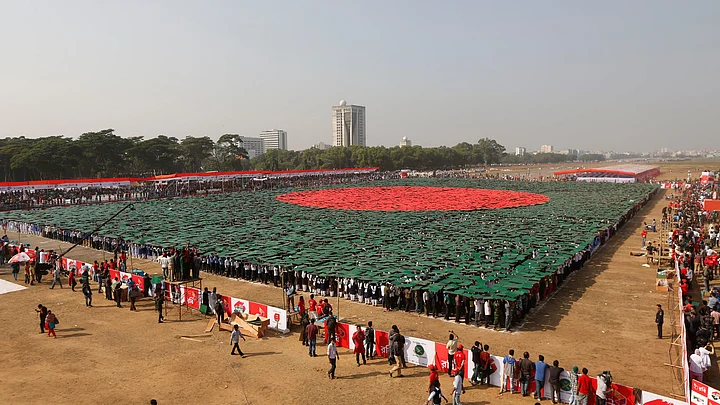(Eight to ten armed terrorists attacked a bakery in the diplomatic zone of Dhaka, Bangladesh on Friday night. The wave of violence in the country over the past months has killed rationalists, bloggers, activists, and members of religious minorities. This article has been republished in light of the attack.)
Like Salman Rushdie’s portrayal of Pakistan in Shame, Bangladesh may be characterised as a place “insufficiently imagined”. As Bangladesh celebrates its liberation from Pakistan, at a time when the country is gripped by frenzy over the hanging of “traitors and collaborators of 1971”, a question assumes salience – is India’s eastern neighbour more Bengali or more Muslim?
This question, surrounding labels of national identity, has bedevilled not just scholars, but also ordinary Bangladeshis. The struggle to come to terms with these two competing identities has brought to the fore other contentious and vexed issues of nationalist politics and nationalism.
There is little disagreement that Bangladesh emerged as a sovereign state in 1971, riding the crest of a language movement politically backed by an equally, if not more, powerful demand for autonomy, and finally secession from the Islamic Republic of Pakistan.
But events since Bangladesh’s liberation and the new state’s tortured and blood-soaked history point to the adoption of a different ideology that has defined its national identity, which is in stark opposition to the secular principles of the freedom struggle.
A Second Revolution?
By adamantly sticking to her position that the martyrs of 1971 must get justice – no matter whether it is retributive – Prime Minister Sheikh Hasina has sought to fuel a second revolution that seeks to transform Bangladesh’s socio-political landscape with ethno-linguistic and ethno-cultural nationalism: a bloody, but just reiteration that Bangladeshis are Bengali first, and the murder of secularist bloggers in recent times – an attempt by resurgent Islamists to defeat the principles of the liberation war.
While Bangladesh continues to represent the “distinctive splendours and menaces of nationalism,” there is no denying that today’s clash of cultures is a reflection of “two economies” – one urban, the other rural. The former is represented by the city-bred, educated, employed elite for whom religious bigotry is anathema to their existence, and the latter represented by the poor peasantry from whom Islamist organisations such as the Jamaat-e-Islami and the Hifazat Andolan draw their foot soldiers.
The economic transformation of Bangladesh over the last decade has changed the status of various occupations and other social groups in ways which have implications for nationalism, as nationalists attract followers from groups which are losing, or seeking to gain social status.
Reinventing the Past
Bangladesh is still a young nation and therefore continues to adhere to the rituals of venerating a nation state founded on the ideals of liberation; a regular reinvention of the past, if you will.
Bangladesh’s national consciousness consists of “two things”, to borrow from 19th century French scholar Ernst Renan: “One lies in the past, the other in the present. One is the possession in common of a rich legacy of memories, the other is present-day consent, the desire to live together, the will to perpetuate the value of heritage […] The nation, like the individual, is the culmination of a long past of endeavours, sacrifice and devotion.”
In a curious sense, the recent hangings in Bangladesh reflect the war waged in 1971, as the Awami League’s second struggle to dissociate itself from, or “forget” Bengali Muslims’ collaboration with the Pakistani state, identified with violence and cruelty.
Hence it becomes necessary to resurrect “evil figures” (Salauddin Qader Chaudhury, Golam Azam, Ali Ahsan Mohammad Mojahid). And in a world ruled by social media, Bangladesh’s young secular bloggers diffused their cultural narratives through new technologies of communication, creating in the process imagined communities through the agency of students.
The Conflict Within
It is this secular conception of the nation that Hasina has sought to recapture when Bangladesh, since the beginning of her second innings as Prime Minister, plunged into a conflict within the majority community.
In her attempt to marginalise and outbid the Khaleda Zia-led Bangladesh Nationalist Party, which has worked persistently to strengthen the place of Islam, the politically wily Hasina has sought to unify large sections of Muslims and the minorities with the call that the common bond of Islam is an insufficient basis to secure the success of a nation, for which her father and most of her family gave their lives. And just like her father, she has given a call – by her determined and uncompromising stand on the hangings and the hunting down of the killers of the bloggers – for the protection of the national culture.
Repackaged Nationhood
Whether her stand will fetch political dividend two years from now when Bangladesh goes to the polls is uncertain. Hasina has used the secular credentials of the liberation movement as a national ideology to conscript people to the idea of another nationhood, not unknown, repackaged in a way that would be appealing for large sections of Muslims and Bangladeshi minorities.
But it also holds the danger of consolidating the Islamists, especially because Bangladesh has historically represented a dual-nation – the secular Bengali and the revivalist Islamist – whose identity is mutable and manipulable. Politics after all has the power to bend social and cultural membership to serve its purpose.
(At The Quint, we question everything. Play an active role in shaping our journalism by becoming a member today.)
